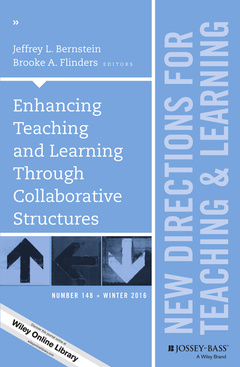Enhancing Teaching and Learning Through Collaborative Structures New Directions for Teaching and Learning, Number 148 J–B TL Single Issue Teaching and Learning Series
Coordonnateurs : Bernstein Jeffrey L., Flinders Brooke A.

- improve the educational experiences of all students,
- model professional behaviors that students will soon be expected to embrace, and
- positively impact graduates, peers, campuses, and even communities at large.
Exploring multiple perspectives on collaborative structures in teaching and learning, this volume discusses ways to consider the collaborative structures within education that allow for shared contributions to teaching and learning. It discusses the need for practitioners to view teaching and learning as truly communal work, regardless of the type of setting.
This is the 148th volume of this Jossey–Bass higher education series. It offers a comprehensive range of ideas and techniques for improving college teaching based on the experience of seasoned instructors and the latest findings of educational and psychological researchers.
Jeffrey L. Bernstein, Brooke A. Flinders
1. Learning in the Company of Others: Students and Teachers Collaborating to Support Wonder, Unease, and Understanding 15
Richard A. Gale
Embracing a shared vision of truly collaborative learning and teaching practice provides students and faculty alike with a richer understanding of the value and potential of working together. Refining roles and expectations allows students to build confidence through disequilibrium and discourse, if we are willing to embrace the risk inherent in these revised collaborative roles.
2. How Students, Collaborating as Peer Mentors, Enabled an Audacious Group–Based Project 25
Jeffrey L. Bernstein, Andrew P. Abad, Benjamin C. Bower, Sara E. Box, Hailey L. Huckestein, Steven M. Mikulic, Brian F. Walsh
The presence of peer mentors enabled a complex project to be implemented in a Campaigns and Elections class, and helped the professor develop a sustainable model that could be used in future iterations of the course.
3. The Development of a High–Impact Structure: Collaboration in a Service–Learning Program 39
Brooke A. Flinders, Matthew Dameron, Katherine Kava
The high–impact educational practices, recommended by the Association of American Colleges and Universities, are embedded in an undergraduate service–learning program and leadership team design.
4. Collaborative Structures in a Graduate Program 51
Robyn Otty, Lauren Milton
Collaboration that extends beyond an individual course creates community, continuity, and leadership opportunities for students in a graduate program.
5. Exploring Academia: Professionalization and Undergraduate Collaboration 65
Ellen G. Galantucci, Erin Marie–Sergison Krcatovich
An undergraduate experience working on a scholarship of teaching and learning project with a professor can have a positive impact on the career development of graduate students (and future faculty).
6. Collaborating in Dialogue for an Optimal Leadership Education 75
Carmen Werder, Joseph Garcia, Jamie Bush, Caroline Dallstream
Leadership education at Western Washington University is examined through four different lenses, each revealing important lessons for how leaders are made or revealed, and the role they play in facilitating dialogue around teaching and learning.
7. Four Positions of Leadership in Planning, Implementing, and Sustaining Faculty Learning Community Programs 85
Milton D. Cox
Faculty Learning Communities (FLCs) provide meaningful opportunities for engagement, collaboration, and development of the scholarship of teaching and learning. This chapter describes new positions of leadership that serve to implement and sustain FLCs.
8. Concluding Comments 97
Jeffrey L. Bernstein, Brooke A. Flinders
Taking stock of the lessons learned in this volume and considering next steps to facilitate future collaboration in the service of teaching and learning incite yet further conversation.
INDEX 103
Brooke A. Flinders is Associate Professor of Nursing at Miami University. She incorporates service-learning and the scholarship of teaching and learning in her community-based work with young women, in the field of teen pregnancy prevention.
Date de parution : 01-2017
Ouvrage de 112 p.
14.7x22.4 cm
Disponible chez l'éditeur (délai d'approvisionnement : 12 jours).
Prix indicatif 31,03 €
Ajouter au panier


